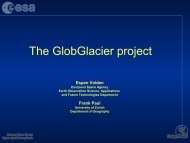proportion
Altai - GLIMS: Global Land Ice Measurements from Space
Altai - GLIMS: Global Land Ice Measurements from Space
- No tags were found...
Create successful ePaper yourself
Turn your PDF publications into a flip-book with our unique Google optimized e-Paper software.
D16107SHAHGEDANOVA ET AL.: GLACIER AND CLIMATE CHANGE IN THE ALTAID16107Figure 2. Monthly climatologies of air temperature andprecipitation for the Akkem (A) and Kara‐Tyurek (KT)meteorological stations for 1952–2004.Between April and October, the westerly flow dominates.The North Atlantic depressions are the main source of precipitationaccounting for 60% of annual accumulation whilethe role of depressions arriving from the south–west increasesin autumn [Aizen et al., 2006]. Snow accumulation occurs inthe Altai throughout the year but predominantly in April–May and October when air temperatures are negative. Themonthly air temperatures are positive at the station elevationsin June–July–August (JJA) and ablation is limited to thisperiod. Mass balance records from the Malyi Aktru Glacier,the World Glacier Monitoring Service (WGMS; http://www.wgms.ch) reference glacier for the Altai (50.08°N; 87.72°E;Figure 1) indicate that the average September–May and JJAmass balances were 680 mm and 780 mm of water equivalent(mm w. e.) respectively in 1975–2008 resulting in an averagenegative annual mass balance of 100 mm w. e. [WGMS, 2007and earlier issues].3. Data and Methods3.1. Glacier Mapping[7] The assessment of glacier surface area in the early 21stcentury and its changes since 1952 was conducted in threestages: (i) glaciers were mapped on the ASTER images andtheir surface areas for 2004 were calculated; (ii) accuracy ofglacier surface area values published in CG [1974, 1977]was evaluated by re‐mapping a sample of glaciers using theoriginal aerial photographs; (iii) change in glacier surface areawas calculated for the glaciers not smaller than 0.5 km 2 (as in1952) selected from (i) and using data published in CG [1974,1977]. For the glaciers that have split into several fragments,the net area change between 1952 and 2004 was based on atotal area of the individual fragments.3.1.1. Mapping Glaciers From ASTER 2004 Imagery[8] Glacier outlines were mapped manually using ASTERimagery (resolution 15 m) from 10 September 2004 for thenearly cloud‐free conditions (Figure 1). GLIMSView software(www.GLIMS.org) was used. The images were obtained fromNASA Land Processes Distributed Active Center wherethey were orthorectified prior to the distribution using PCIOrthoEngine software [Lang and Welch, 1999]. The imageswere supplied in WGS1984 UTM zone N44 projection. Theaccuracy of the orthorectification was verified using a networkof the interactive ground control points (GCP) establishedduring the GPS ground surveys in August 2007. Thehydrographic and topographic features on stable terrain in thevicinity of glacier termini were used as GCPs. The error ofdetermination of GCP on the ground did not exceed 3–5 mand the root‐mean‐square‐error (RSME x,y ) values were lessthan a size of ASTER pixel (15 m). Earlier assessments haveconfirmed that human interpretation remains the best toolfor extracting detailed information from satellite imagery forglaciers if they are at least partly debris‐ and snow‐coveredparticularly when mapping is conducted by the same personusing a combination of different types of imagery [Paul et al.,2002; Raup et al., 2007]. The International Space Station(ISS) photographs taken on 9 August 2006 with a resolutionof 5 m and an archive of terrestrial photographs were used forvisual analysis providing additional information for the glacierboundary delineation.[9] Snow, continuous debris cover and shadows are thewell‐known sources of uncertainty in glacier mapping. Theextent of snow cover is at its annual minimum in the Altai atthe end of August–beginning of September. On 10 September2004, conditions were suitable for glacier mappingas glacier tongues were clearly visible on the image acrossthe study area. The <strong>proportion</strong> of glacier surface covered bydebris is comparatively low in the study region [CG, 1974,1977]. Where glacier margins were obscured by shadows, acontrast‐stretching function was applied to the ASTERimagery using ENVI 3.5 software. To estimate the errorintroduced by these factors, we compared areas of thirtyrandomly selected glaciers derived from the same ASTERimage by three independent operators. This comparisonyielded an error of ±2.1%. Surazakov et al. [2007] estimatedareas of seven glaciers of the Aktru basin using highresolutionPRISM imagery for 2006. A comparison of theseresults with the areas of the same glaciers derived fromASTER 2004 imagery yielded an error of ±1%. An error of±2.1% was, therefore, added to the 2004 glacier area estimation.Previous studies indicated a typical accuracy ofglacier mapping of 3–4%forsimilarorlargersamplesofrandomly selected glaciers [Paul et al., 2002; Bolch andKamp, 2006;Kutuzov and Shahgedanova, 2009].3.1.2. Verification of the Catalogue of Glaciers DataUsing Aerial Photographs[10] The individual glacier surface areas published in CG[1974, 1977] for the study region were derived from theaerial photographs from 24 August–3 September 1952. Thepublished values were verified by re‐mapping a sample of21 glaciers using a set of 37 original aerial photographs(Table 2). The aerial photographs were suitable for glaciermapping as glacier tongues were free of snow. The testglacierschoseneitheramongthosesurveyedin2007inthefieldorrandomlyrangedinsize(0.8km 2 –22.6 km 2 as in2004) and in changes of surface area.[11] Resolution of the aerial photographs was 1–3 m. Thepaper prints of the aerial photographs were digitised at 600dpi (1 m resolution). The instability of the paper baseintroduced distortions of 0.2–0.6 pixel (about 0.2–1.7 m inTable 1. Meteorological Stations Used in This StudyMeteorological station Lat (N) Lon (E) Altitude (m) Observation periodKara‐Tyurek 49° 59′ 86° 28′ 2600 Since 1939Akkem 49° 55′ 86° 32′ 2056 Since 1950Aktru 50° 05′ 87° 47′ 2110 1958–19943of12





